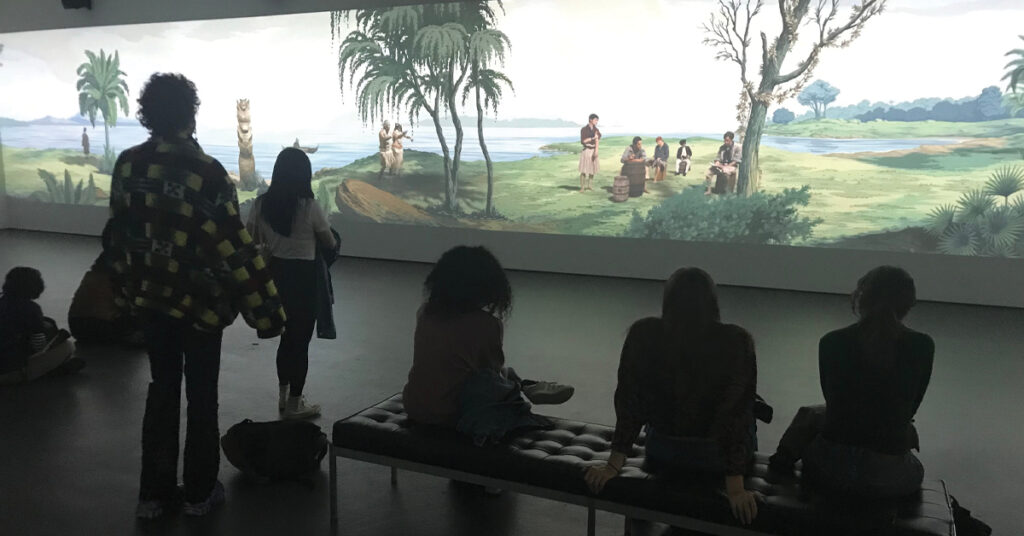
The minute I stepped into the large empty room of the exhibit, I was blown away by the size of it. I was instantly intrigued by the large moving screen of a painting of a Pacific island projected on the wall. In the foreground were people walking around and interacting with each other in the projection. Some were dressed as the European explorers, others as Pacific Islanders from the same era of colonial expansion. I watched their interactions in front of this painted background like it was a dramatic movie, and I could not wait to see what would come next in the scrolling panorama of the videos of them. The room was cool, almost as if wind was blowing, but I am sure I was just imagining being on the island with the people, since they were so close moving right in front of me. I couldn’t help but keep my eyes glued to the screen as I watched the variety of interactions taking place as the scenes and sounds slowly scrolled across the room, playing out until the scene reached the end of the wall.
Lisa Reihana’s immersive creation, in Pursuit of Venus [infected], utilizes modern technology to provide viewers the opportunity to learn about 18th century European exploration of the Pacific from a new perspective. Reihanna uses the 19th century French wallpaper Les Sauvages de la mer Pacifique (The Native Peoples of the Pacific Ocean), 1804-1805 by Joseph Dufour et Cie, to serve as the Pacific island landscape background behind recordings of real-life actors who reenact a plethora of scenes from the European explorers meeting the native Māori and other Pacific Indigenous peoples. Music, sounds, and video recordings of the actors create the immersive experience for the viewer. The technology of this exhibit generates curiosity and uncertainty as you get to watch the typical behavior and sometimes conflict between the groups of people.
Reihana, who is Māori herself, has a mission of reimagining the previous fantastical, Neoclassical depiction of Captain James Cook and his voyages. Instead, her work provides an accurate understanding of both the peaceful and violent interactions between the European settlers and native Pacific Islanders. She does this by transparently illustrating the exchanges between the two culturally distinct groups. Reihana states, “I challenge the stereotypes that developed in those times and since, and the gaze of imperialism is turned back on itself with a speculative twist that disrupts notions of beauty, authenticity, and history and uncovers myth-making.”
Kate Krazcon, the curator of the David Winton Bell Gallery at Brown University, shares her insight on the value and mission of Reihana’s work: “Reihanna is not moving towards authenticity; that is not what she is trying to achieve. She is trying to kind of reimagine, not depict historical moments, but reimagine what could have happened in terms of miscommunication across British and Native Pacific Islanders in terms of their encounters.”
Krazcon elaborated on the true motivation behind Reihanna’s efforts as she explained that the exhibit demonstrates how exploration was not simply the British coming and dominating the land because they had firearms or large and impressive ships. Rather, there were many moments of cultural exchange and appreciation between the different groups of people.
Finally, Krazcon comments on the impact that the cinematic technology has had on the public’s engagement with the exhibit: “I think that when you draw from cinematic strategies, people are more likely to engage with work, versus if she just made another print of the wallpaper … It draws you in. People tend to spend a lot of time when they go into the piece and I think that was her intent. It was also to activate and get the agency to the indigenous peoples of the original wallpaper because they were depicted so incorrectly historically.”
A note of warning to anyone who attends: Time passes differently in the exhibit. Something about the relaxed but constant pacing made me expect to stay only a few minutes, but when I checked my phone it had been 30. To go centuries back in time seems to take a little contemplation time.